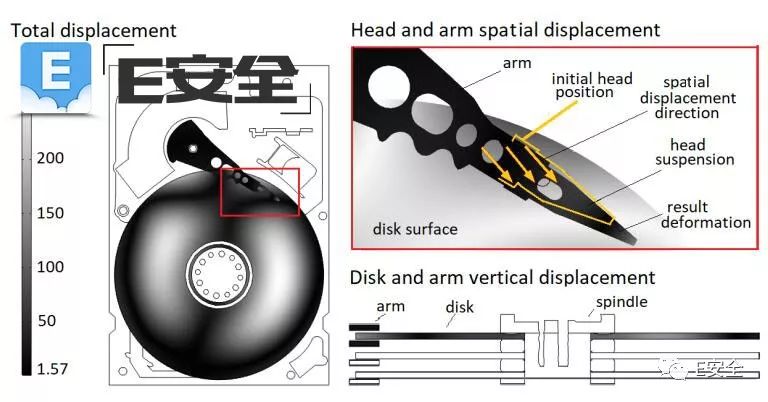June 6th Researchers at Zhejiang University and the University of Michigan published their study “Using Sonic Attacks to Destroy Hard Drives†at the IEEE 2018 Security and Privacy Symposium (5.21-5.23). During the demonstration of this kind of sonic attack, researchers can use the built-in speakers of the target computer to play ultrasonic sounds, or use the speakers near the target device to physically damage the hard disk and even cause the computer to crash.

Hard disk operation risk
Traditional hard disks store data through a circular disc coated with a magnetic material, and use a head to position and read recorded data. When reading data, since all reading and writing operations require mechanical operations, the traditional hard disk needs a stable environment during operation to avoid the occurrence of vibrations and abnormal operation. In severe cases, the read/write head hits the disk. The hard disk and the data in the hard disk are permanently damaged due to disk drive.
Different objects react differently to sound waves at different frequencies. When the object vibrates below a certain frequency more than other frequencies, it is called the resonance point of the object. Computer components, of course, have resonance characteristics. For the conventional hard disk drive in which the only two computer systems still use the principle of mechanical operation, resonance easily causes the head to deviate from the track, resulting in read/write failure and affecting the overall operation of the computer system. .
Sonic attack destroys the principle of the hard disk
As the mechanical hard disk drive (HDD) was exposed to physical vibrations, the researchers demonstrated that special sound signals can cause significant vibration in the HDD's internal components, eventually leading to a crash of the HDD-dependent system.
In order to prevent head collisions caused by acoustic resonances, modern HDDs use a feed forward controller driven by a shock sensor to detect such activity and improve head positioning accuracy when reading and writing data. However, research papers published by this group of researchers show that acoustic and ultrasonic signals can cause false alarms from the shock sensor, causing the head of the HDD to return to the start-stop area in an unnecessary situation. The Sonic Attack demonstration shows that attackers can successfully attack HDDs in CCTV systems and desktop computers.

The research paper states that an attacker could exploit the vulnerability of the hard disk to cause system-level consequences, such as causing the laptop's Windows system to crash through built-in speakers or preventing the surveillance system from recording video.
An attacker could trick a user into playing this malicious audio in an email or web page, launching such an attack with a nearby external speaker or a built-in speaker built into the target system.
Experimental results: Multiple brands of mechanical hard drives affected
The researchers tested a variety of HDD sonic and ultrasonic interference tests in experiments. The brands involved include Seagate, Toshiba, and Western Digital. Experiments have found that ultrasound can cause mechanical hard disk errors in as little as 5-8 seconds. Sonic interference that lasts longer than 105 seconds or longer causes the Western Digital HDD in the video surveillance device to stop recording from the beginning of the vibration until the device restarts.
The researchers explained that if the victim is not in the vicinity of the attacked system, the attacker can use any frequency of sound (including the human ear can hear) to attack the system. The real-time video stream of the system does not show signs of attack. In addition, the system does not provide any way to understand the audio in the environment. Therefore, if the victim is not in the vicinity of the system, the attacker can use the audio to launch the attack without being aware of it.
Researchers can also destroy HDDs on desktops and laptops running Windows and Linux operating systems. They can take a Dell XPS 15 9550 laptop in just 45 seconds and crash it in just 125 seconds.
How to defend?
Researchers have proposed defense measures to detect and prevent such attacks, including:
Deploy new feedforward controllers to reduce acoustic interference through firmware updates
• Detect the activity of the ultrasonic-triggered shock sensor and prevent the magnetic head from returning to the start-stop area when it is not necessary through the sensor fusion method.
Use sound attenuation material to weaken the signal.
Outdoor Mobile LED Kiosk Poster
The Best Advertising choice and the best money earning machine--Outdoor LED screen kiosk
Outdoor Led Kiosk Poster also called led AD Kiosk player is one of new applications for led displays. Developed from led screens, it is more suitable and friendly to operate. Don't need to install as it is floor standing. and could be put anywhere it needed indoor or outdoor environment.
Optional Pixel Pitch 4mm,5mm,6mm.optional sizes 60`'.IP65/54, weather proof; Ultra Outdoor HD led display Kiosk poster, crystal clear and vivid images; High brightness and auto adjustment according to environment; Intelligent group management, easy and convenient. Thanks to the Cluster controll system and GPS technology, no matter how many posters you have where they are, you could controll them easily and change content quickly.
They are one of none stop money earning machines!
Intelligent monitoring and GPS
High brightness for outdoor and energy saving
Outdoor Mobile Led Poster,Mobile Led Poster,Outdoor Display Of Mobile Led Poster,Led Screen Of Window Signage
Shenzhen Priva Tech Co., Ltd. , https://www.privaled.com